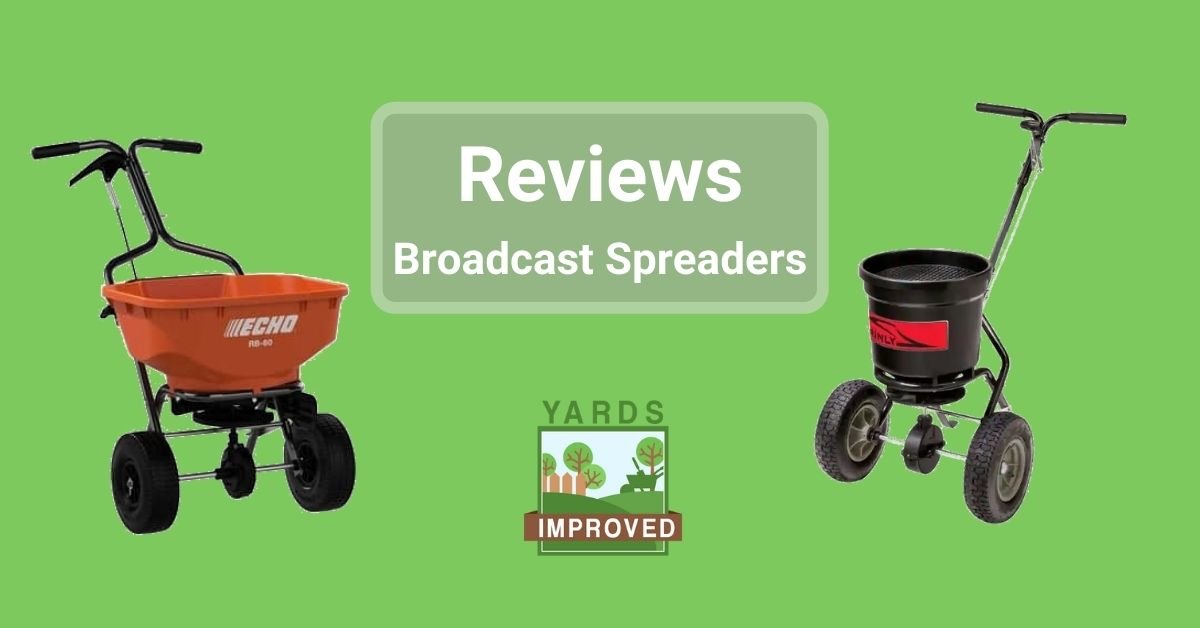Fertilizing and reseeding the lawn are annual necessities. In fact, you should do them more than once a year. A broadcast spreader is a great addition to your toolshed to help get these tasks done quickly and effectively. Let’s take a look at what you should consider and some of the best options you can buy.
What To Look For In A Broadcast Spreader
In this article, we’re going to talk about the type of broadcast spreader that you push. There are also models that you can tow with a tractor or lawnmower, but those deserve an article of their own. And drop spreaders that perform a similar function but spread the seed in a different way. Each has its positives and negatives.
A broadcast spreader is also known as a rotary spread. It works by tossing seed out on all sides as you push it along. This is in contrast to a drop spreader, which drops the seed directly below the spreader.
Here are some things to keep in mind:
Capacity
There are many sizes of broadcast spreaders. They’re measured according to how many pounds of grass seed they can hold. A walk-behind model is good for small or medium yards without needing to refill it. Of course, you can always add more seed, but it’s easier to do everything in one shot.
Range
Different spreaders will toss the seed or fertilizer farther from the unit. You don’t need one that tosses it too far if you only have a small area to cover. You don’t want it wasted by falling on the driveway or sidewalk. But if you do have a wide area to cover, a decent range of 6 or more feet may help get the job done faster.
Settings
A good spreader will let you calibrate the dispensing rate.This changes the size of the hole that the seed falls through. When the hole is open wider, more seed comes out for the same distance you move the spreader. That’s great when you need to seed or fertilize an area that needs more seed.
It will take some time to figure out the appropriate setting for your situation, as well as the pace you need to walk.
Pros and Cons of a Broadcast Spreader
A broadcast spreader lets you cover a wide area in a short amount of time. And that’s both its advantage and its disadvantage.
You can finish the job more quickly, but as you go back and forth along the lawn, you’ll end up with some spots seeded more than others. That can become obvious when the grass sprouts!
Also, be careful not to start too close to an area you don’t want to seed, such as a garden bed or paved surface. If your spreader broadcasts seed about two feet, start two feet from the edge to keep as much seed or fertilizer on the lawn itself.
You also need to push the spreader at a consistent rate to get an even spread. Your walking speed controls how much seed shoots out, so keep a steady pace. This is different from a drop spreader, which deposits seed based on distance traveled instead of speed.
Top-rated Broadcast Spreaders For Grass Seed and Fertilizer
Ready to buy a broadcast spreader? Here are some of the ones you should consider. They’re good deals and offer a product that will help keep your lawn looking great!
Scotts Turf Builder EdgeGuard Mini
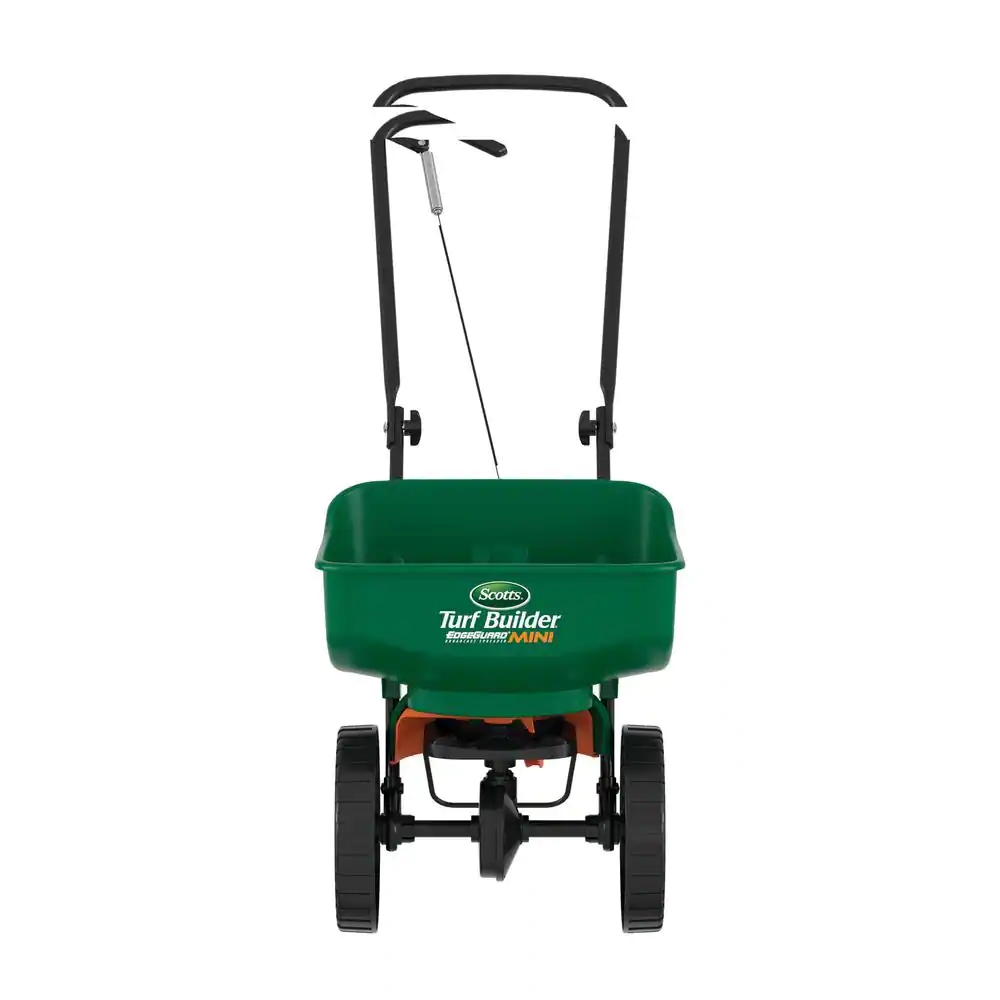
Of course, Scotts has to rank up there when it comes to spreaders; they’re probably the best-known name in both seed and fertilizer! And the Edgeguard Mini is a great little broadcast spreader. If you have a small yard, it’s definitely worth your consideration.
This rotary spreader holds enough seed to cover about 5000 square feet; that’s a 15-pound capacity.
One of the best features is that it allows you to block seeds on the right-hand side, so you don’t have to worry about tossing seed into unwanted areas.
The control knob is easy to adjust and is keyed to the number listed on packs of Scotts brand products. It spreads seed about 4 feet to either side.
Any complaints we’ve seen about this spreader have to do with lines where seed didn’t fall. However, this would seem to be user error rather than anything else.
It also features a fold-down handle to make storage easy.
This is a good entry-level product with an entry-level price. For light work and a small yard, it’s fantastic
Brinly-Hardy 50 lb. Capacity Push Broadcast Spreader
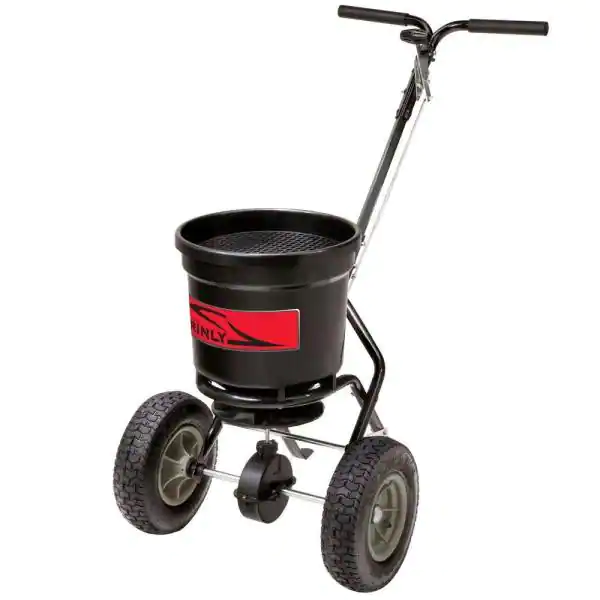
This spreader from Brinly-Hardy may look like just a bucket on wheels, but it works great!
With a 50-pound capacity, it will let you cover up to half an acre without refilling.
It’s solidly constructed, with a durable plastic hopper and metal frame. The tires are sturdy. They’re also large – 12 inches high and 3 wide – to help you navigate rough spots in the terrain.
This works equally well with snowmelt as with grass seed and fertilizer.
Echo RB-60 Spreader
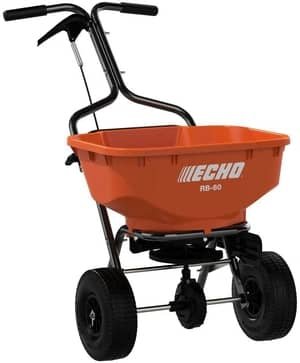
This broadcast spreader holds up to 60 pounds of seed or fertilizer. It spreads seed across about 8 feet of lawn, helping make the job go quickly. And like some other models we’ve reviewed, it does have a deflector to block seed on one side when needed. In this case, it’s even easy to operate with your foot!
The 10-inch tires are good enough for the weight they bear and make it easy to push the unit even across uneven surfaces.
There are 9 different settings you can choose for the spread rate. It also closes without the need to use a special switch; to run it, though, you have to hold the handle open.
When considering the price as well, it’s easy to consider it among the best options in its class.
Earthway Even Spread 2170
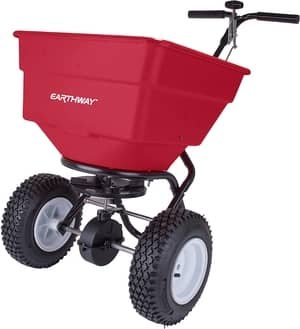
Ok, this is a huge rotary spreader! It has a 100-pound capacity and 13-inch stud tires to support it. You’ll have an easy time seeding a large lawn with that. The wheels are sturdy enough to make pushing it around not too difficult, either.
This does feature a guard to prevent seed from spreading on one side, a useful feature as we’ve noted above.
Assembly isn’t the simplest; the instructions could be clearer. It could also stand to have a few more washers in strategic locations.
But once you get it together, you’ll find this purchase worthwhile. Of course, the price tag is a bit high, but that’s to be expected when the hopper is this large.
Agri-Fab 85 lb. Push Broadcast Spreader
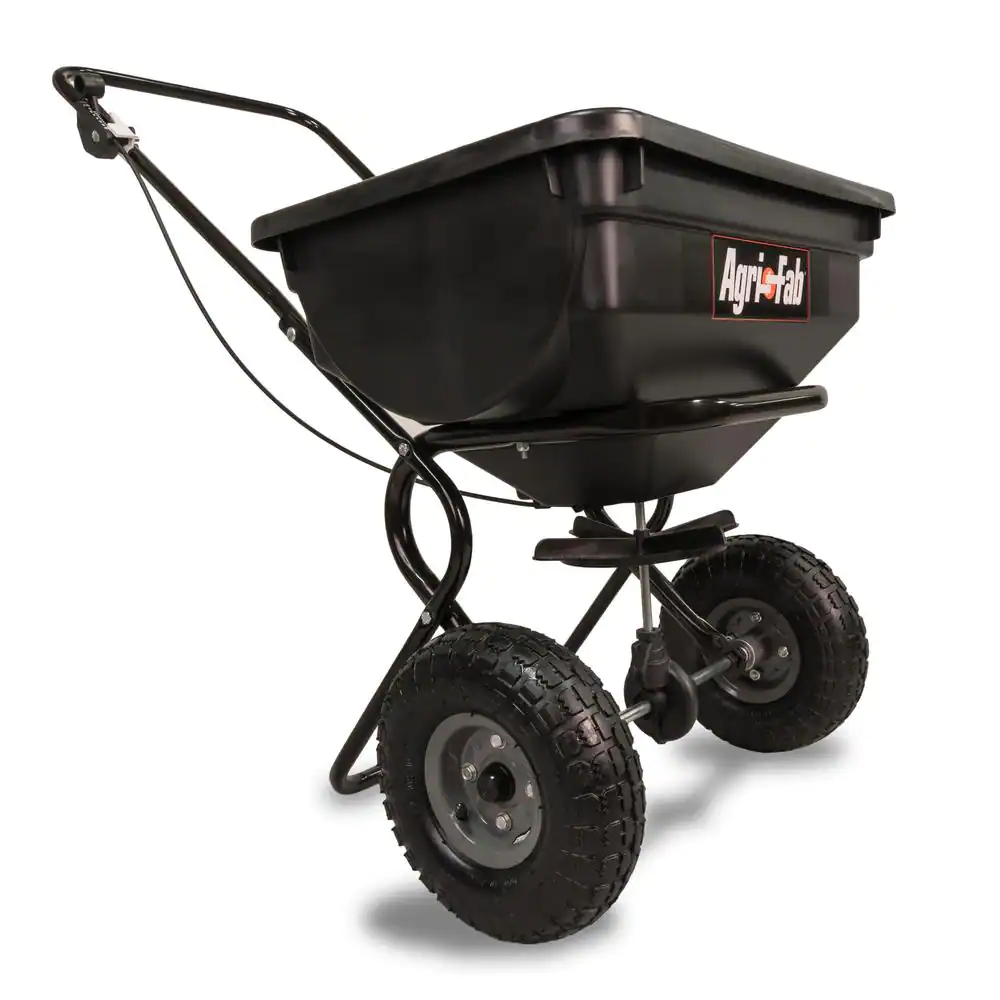
This is an even larger-capacity spreader with a wide spreading range. It holds up to 85 pounds of seed, enough to cover even a large lawn. And it can broadcast that seed up to 10 feet!
It works well with seed, fertilizer, and ice melt. The 10-inch pneumatic tires make it easy to maneuver, as well.
The controls for on/off and speed are easy to read. Of course, “on/off” simply determines whether it will toss seed or not; it’s not a powered device.
It’s an ok model, but the individual components could be of better quality. It’s difficult to assemble and we recommend taking special care in its use. It can work well, but it’s not the toughest piece of equipment.
Conclusion
A rotary, or broadcast, spreader can help you seed or fertilize your lawn in record time. By just pushing it along, you spread your chosen product through a swath based on your speed and the setting. It does take a little while to develop the appropriate speed to walk, but you’ll appreciate the ease with which you can complete the task!

